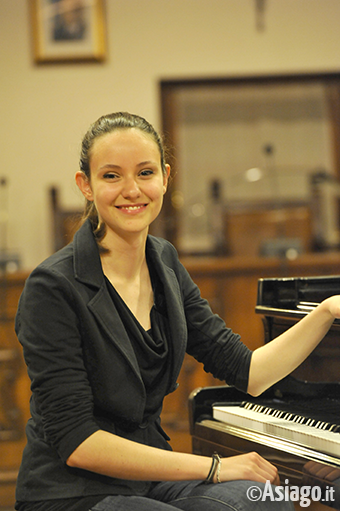Thursday 28/8/2014 at 21:00
Concerts

Sala s. Giustina-Roana-music by Beethoven, Frank, Liszt, Scriabin-Thursday, August 28
Culture & music arranges for Thursday, August 28 , the concert pianist Chiara Fridge that will propose a program of excerpts from Beethoven's music, Frank, Liszt, Scriabin. The appointment is for the hours 21.00 at the sala Santa Giustina di Roana.
The program will present, a. Scriabin, the Sonata No. 6, op. 62. The Sonata consists of a single movement "Modéré: mysterieux concentré"and is characterized by a mysterious atmosphere, with surprising aspects, such as the sudden movements of horror that interrupt its dreamlike atmosphere, and that are called by the same Scriabin épouvante surgit "l" (wave of terror). Scriabin never played it in public, because he believed it was cloudy, impure, malicious, a terrible nightmare, and often playing the Sun rabbrividiva the first four bars.
Will follow the Prelude, Choral et Fugue of Cesar Franck: as its name suggests, consists of three movements: a prelude, a Chorale and a Fugue. Such work is characterized by a thematic interconnection between the three movements, in particular the cyclic recall of the Chorale Prelude and the fugue. This work is an example of Franck's distinctive use of cyclic form.
The famous Piano sonata no. 23 in f minor, op. 57, by Ludwig van Beethoven, commonly called "Appassionata", was composed between 1804 and 1805, and perhaps 1806. The first edition was published in Vienna in February 1807, the author dedicated to count Franz von Brunswick.
The Passion is in three movements: Allegro assai, Andante con moto (in d-flat major)-attacks: Allegro, ma non troppo – Presto.
In an atmosphere typically in Beethoven is imperious and almost aggressively the initial theme of the Allegro assai, which the composer worked long before getting the final form. The second theme comes strictly from the first, but buy a different character, more to choral music and elocution oratoriale, as noted in its time Ferruccio Busoni. Is there a prospect of trust and hope, unlike the substantially distressing theme and the concept of struggle against fate, emerging in the creative vision of Beethoven.
You reach the marvelous Andante con moto of the second movement, page among the highest and intimately expressive processed by the composer for the piano. Is a simple theme, which is believed to derived from a popular Christmas Carol, built on three variations of extraordinary harmonic and melodic strength; the first serious log, the second in the middle and the third in that dull.
The Sonata ends with a soon, a classic final with a narrow range of tonal differentiation which testify how difficult to manage Beethoven kept under Sun piano resources. The theme of the finale of the Sonata Beethoven occurred during a walk with his pupil Ferdinand Ries. You know that the first movement of the Sonata had a difficult gestation with a long elaboration of thematic and rhythmic material, as is apparent from the numerous sketches on the first and second half of the "Appassionata", appropriately studied and admired by artists open to new, as Berlioz, Liszt and Wagner.
End the song extremely virtuosic concert, the Totentanz (dance of death in Italian) by Franz Liszt: is a danse macabre for piano and orchestra composed between 1834 and 1859 by Franz Liszt and then transcribed by Liszt for solo piano.
The Totentanz is a paraphrase on Dies Irae (day of judgment), which is a theme of medieval origin, which many composers have taken over time. The Totentanz is structured as a song to "difference": takes a reason (the theme), the view at the beginning and then it repeats found through variation each time in a different way. The beginning of this song, with the piano used almost as a percussion instrument, is one of the experiments that Liszt performs in this composition which features rugged technical difficulties.
Clear the fridge was born in Asiago in 1993. He began piano studies at the age of 5 years with Professor Andreja Ravnic. At 12 years old was admitted at the Conservatory a. Pedrollo in Vicenza under the direction of professor r. Zancan from dawn. In 2009 he completed piano less than getting the highest marks. Since 2010 she studies with Professor Cristina star. In 2012 he completed middle getting an average of 9.56 in 2013 and is admitted to the 10th over with the highest grades.
During his piano path participates in national and international contests; to remember the concorso nazionale pianistico "Vito Frazzi 2007 Edition" where he was awarded the first prize with 98/100, the "25° national" J.S.Bach Piano competition where he was awarded the third prize with 82/100 and the "IX international competition of musical performance city of Asti" where he was awarded the second prize with 93/100 (1st prize not awarded). Participates annually at the Saturday organized by Musical Conservatory a. Pedrollo where performs songs like "dance of gnomes" study by f. Liszt concert, study No. 1 op. 25 Chopin, n. Rota Prelude No. 5., Rachmaninoff prelude op. 23 no. 5. We should also mention the participation at the concert on the occasion of the bicentenary of f. Liszt, arranged from the Conservatorio di Vicenza, in which Chiara performs "the legend of St. Francis of Paola walking on the waves" by.F. Liszt.
Refines its preparation by participating in various masterclasses with teachers of national and international renown, as Filippo Gamba, Aleksandr Madzar, Leslie Howard and Benedetto Lupo.
As always, admission is free.
All rights reserved.